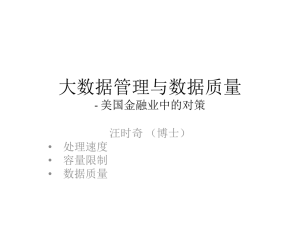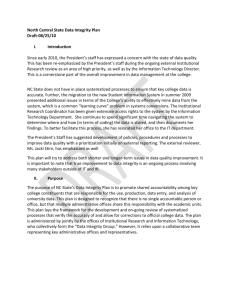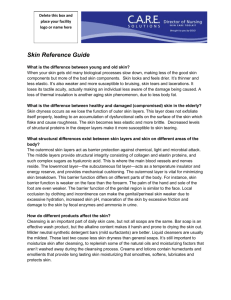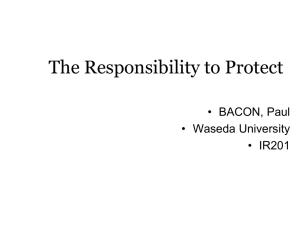The Data Cleansing Process
advertisement
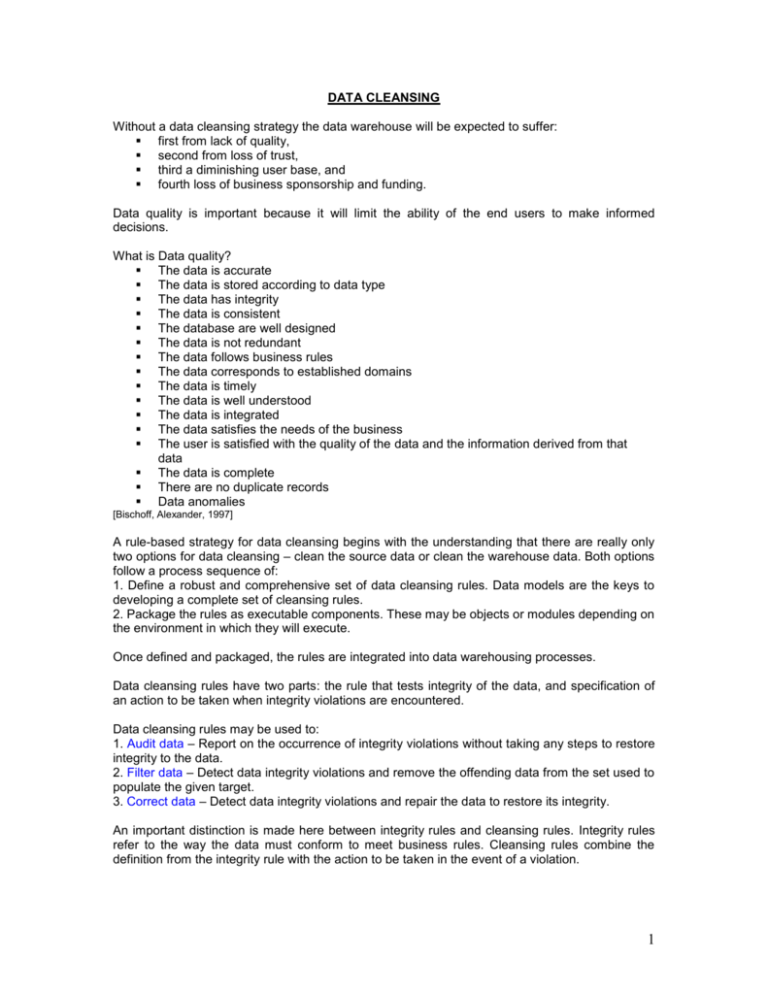
DATA CLEANSING Without a data cleansing strategy the data warehouse will be expected to suffer: first from lack of quality, second from loss of trust, third a diminishing user base, and fourth loss of business sponsorship and funding. Data quality is important because it will limit the ability of the end users to make informed decisions. What is Data quality? The data is accurate The data is stored according to data type The data has integrity The data is consistent The database are well designed The data is not redundant The data follows business rules The data corresponds to established domains The data is timely The data is well understood The data is integrated The data satisfies the needs of the business The user is satisfied with the quality of the data and the information derived from that data The data is complete There are no duplicate records Data anomalies [Bischoff, Alexander, 1997] A rule-based strategy for data cleansing begins with the understanding that there are really only two options for data cleansing – clean the source data or clean the warehouse data. Both options follow a process sequence of: 1. Define a robust and comprehensive set of data cleansing rules. Data models are the keys to developing a complete set of cleansing rules. 2. Package the rules as executable components. These may be objects or modules depending on the environment in which they will execute. Once defined and packaged, the rules are integrated into data warehousing processes. Data cleansing rules have two parts: the rule that tests integrity of the data, and specification of an action to be taken when integrity violations are encountered. Data cleansing rules may be used to: 1. Audit data – Report on the occurrence of integrity violations without taking any steps to restore integrity to the data. 2. Filter data – Detect data integrity violations and remove the offending data from the set used to populate the given target. 3. Correct data – Detect data integrity violations and repair the data to restore its integrity. An important distinction is made here between integrity rules and cleansing rules. Integrity rules refer to the way the data must conform to meet business rules. Cleansing rules combine the definition from the integrity rule with the action to be taken in the event of a violation. 1 FIGURE 1: Classifying Integrity Rules Identity rules – ensuring that every occurrence of an entity is uniquely identifiable. Reference rules – preventing “dead end” navigation of relationships. Cardinal rules – ensuring that cardinalities expressed in the data model are implemented. Inheritance rules – ensuring the integrity of specialization (sub-typing) structures. Value set rules – governing the set of allowable values for each attribute. Relationship dependency rules – enforcing business rule associations among relationships. Attribute dependency rules – enforcing business rule associations among attributes. [Kelly, 1997] The Rule Based Cleansing Process Once a set of integrity rules has been identified and documented, they need to be translated into data cleansing rules. Remember, an important distinction has been made between integrity rules and cleansing rules. Integrity rules refer to the way the data must conform to meet business rules. Data cleansing rules combine integrity rules with specified actions to be taken when rule violations are detected. Determine the action to be taken from perspectives of: At which data is the rule directed – source data or target data? What type of cleansing action is being performed – auditing, filtering, or correction? At what point in the warehousing process will the cleansing action occur? The cleansing actions possible can be broadly grouped into the following three categories: Audit: Tests data against integrity rules and individually and/or statistically reports rule violations. Helps to know size and scope of integrity situation, but does not fix any problems. Filter: Tests data against integrity rules and removes data that violates the rules from the set of data used to populate the given target. Filtering may be applied at any of several levels including removal of individual data elements, removal of entire records or rows, and removal of logically related sets of data. Use filtering cautiously, as it may result in a target with incomplete information. Correct: Tests data against integrity rules and repairs data found to be in violation (using logic defined by the business). Repairs may involve finding an alternate data source, deriving a value from other data, using a default value, etc. The table below contrasts source data cleansing with target data cleansing. These are helpful guidelines in choosing which approach to take with the data in specific warehousing environments. Balancing these variables can help the project team make the best choice for each situation. 2 Source Data Cleansing Requires source data models Typically large number of rules Implicit rules difficult to determine Fixes problems at the source One fix applies to many targets May require operational system changes Target Data Cleansing Rules from target data models Typically smaller number of rules Implicit rules readily identified May only fix symptoms Multiple targets may = redundant cleansing Avoids operational systems issues Rule based data cleansing choices are auditing, filtering, or correction of data ranging from source data to target data in the warehousing process. Completeness, complexity, and cost must all be considered when developing a data cleansing strategy. Figure below illustrates relationships among these variables. In general, it is true that auditing is the least costly and least complex action, but also the least complete solution. Correction is generally the most complex and costly, but also the most complete solution. It is also true that cleansing of source data offers a more complete solution, at higher cost and greater complexity, than does cleansing of target data. FIGURE 2: Data Cleansing Economics [Duncan, Wells, 2000] Conclusion Choosing a technique and deciding which data to cleanse depends on many factors including the severity of the “dirty data” problem, the availability of data models from which to extract rules, and the time and resources that can be committed to data cleansing. It is clear however, that a systematic, structured, and proactive approach to data cleansing yields better results than an unstructured and reactive approach. Use the principles summarized in the table below as the basis to develop a comprehensive and sound approach to data cleansing. Data quality directly affects data warehouse acceptance. Source data is typically “dirty” and must be made reliable for warehousing. Data models are a good source of data integrity rules Both source and target data models yield integrity rules. Data cleansing rules combine integrity rules with actions to be taken when violations are detected. Both source data and target data may be cleansed. Auditing reports data integrity violations, but does not fix them. Filtering discards data that violates integrity rules. Correction repairs data that violates integrity rules. Choice of techniques involves severity of the data quality problem, available data models, and commitment of time and resources. Whatever techniques are chosen, a systematic, rule-based approach yields better results than an unstructured approach. FIGURE 3: Principles of Rule Based Data Cleansing [Duncan, Wells, 2000] 3 Remember that source data models are likely to be out of date, incomplete, or nonexistent. As part of any complete data warehousing project, validation or creation of source data models will be performed. Use these same models as part of the data integrity analysis process. Every data warehousing project also produces target data models, and these models provide useful input to data cleansing. Remember, too, that source systems change over time, as does the data warehouse. The data models must be kept up to date in order to be useful in the integrity analysis process. As the data models and the warehousing environment evolve, it is logical to conclude that the cleaning process will also be a continuously changing process. Bibliography: [Bischoff, Alexander, 1997]: Data Warehousing; Joyce Bishop and Ted Alexander, 1997 [Duncan, Wells, 2000] Rule Based Data Cleansing for Data Warehousing; Karolyn Duncan and David Wells [Kelly, 1997]: Data Warehousing in Action; Sean Kelly, 1997 4

